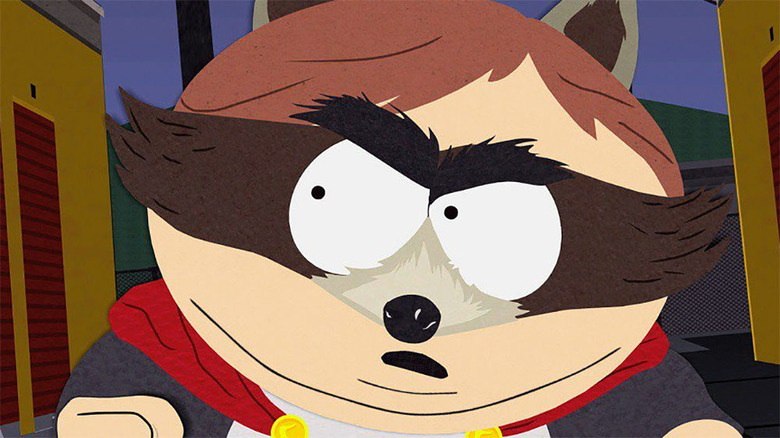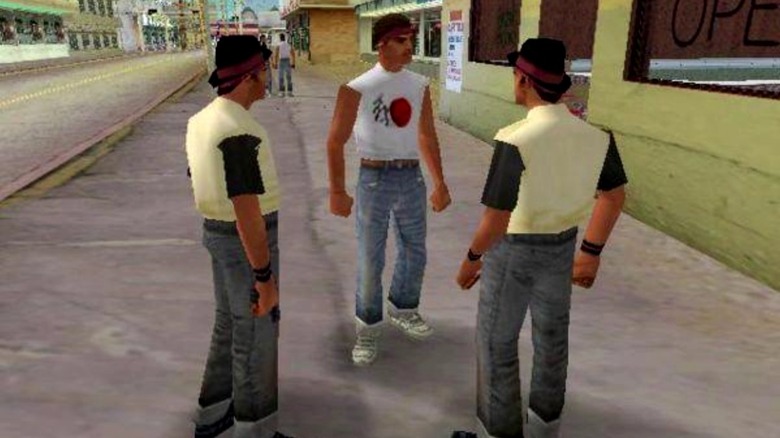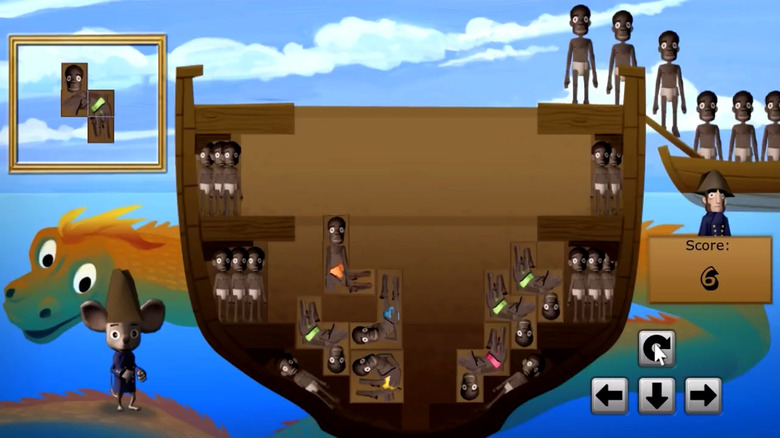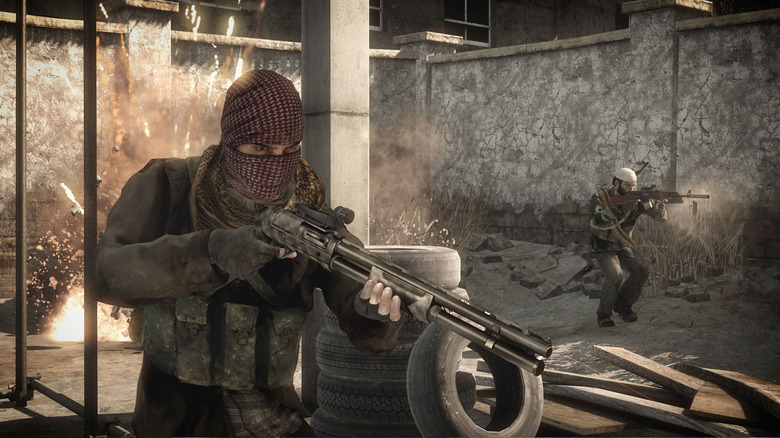Gaming Moments That Took Things Too Far
Video games can tell emotional, thought-provoking stories. They can transport players to fantastic new worlds, and push technology's boundaries to their limits. They can also be racist, sexist, insensitive, and just plain gross.
But there's a difference between pushing the envelope and obliterating it completely. These games do the latter. Intentional or otherwise, every single one of these games has something in common: they contain scenes that are so vulgar, offensive, or politically incorrect that they completely change the definition of "bad taste." How far is too far? You're about to find out.
Grand Theft Auto: Vice City's racist gang war
Vice City might not be an actual place, but it's clearly based on one. Like Miami, Rockstar's real-life inspiration for the game's setting, Vice City is home to a diverse population made up of many different ethnic groups. Unlike actual Miami, however, everyone in Vice City is an unrepentant criminal scumbag. Regardless of race, color, or creed, everyone in Grand Theft Auto's sixth installment completely deserves everything that's coming to them.
Still, there are some lines you shouldn't cross, even in a satire-heavy game like Grand Theft Auto. Genocide is one of them. During Vice City, protagonist Tommy Vercetti gets wrapped up in an ongoing conflict between the community's Cuban and Haitian gangs. While Tommy ends up helping (and fighting against) both sides, the game's overall presentation, particularly while Tommy's siding with the Cubans, leaves something to be desired. See, Vice City refers to both groups by their ethnicity, and prompts encouraging players to "kill the Haitians" or "kill the Cubans" come across less like a feud between criminals and more like a call for ethnic cleansing.
Advocacy groups noticed and complained accordingly. New York Mayor Michael Bloomberg threatened to take legal action if the offending phrases weren't removed. In response, Rockstar and publisher Take-Two buckled. Later versions of the game referred to the two sides using gang names, not ethnic titles, and removed the offending dialogue. Grand Theft Auto: Vice City is still very, very edgy, but it no longer advocates the extermination of an entire race. That's probably for the best.
Dead Space 2's interactive eye-poking
Dead Space 2 is a survival horror game, so a certain level of violence isn't just understandable, it's expected. Still, Dead Space and most of Dead Space 2 trade more on a moody atmosphere and paranoia-inducing jump scares than straight-up violence. The blood isn't the point. It's simply there to hint at how bad things are going to get...until you get to Dead Space 2's infamous eye-puncturing scene, that is.
In order to progress in the game, the series' hero, Isaac, needs to undergo surgery. Specifically, he needs to send a needle through his eye and into his brain, which will unlock the knowledge he requires to proceed. Oh, and you're the one performing the procedure.
You don't need to suffer from trypanophobia, or fear of needles, to understand why this scene is so harrowing. Just play it once, and you'll get it. For one, you need to make sure that the device goes straight through Isaac's iris, which is hard to do given how erratically Isaac moves. Even worse, if you miss, the game ends, although not before showing a cutscene in which Isaac's eye bursts open in a shower of blood. Dead Space 2 is an unsettling game, and yet among all of the interstellar horror, this scene still stands out. That's a good indication that maybe, just maybe, the developers have pushed the envelope a little too far.
Playing History: Slave Trade's slave Tetris
Playing History: Slave Trade allegedly has good intentions. According to the developer's website, the game is designed to teach children about "the horrors of the transatlantic slave trade" first-hand. By casting players as a ship's steward on a transatlantic slaving voyage, Playing History: Slave Trade aims to illuminate just how inumane slave trafficking was through a series of mini-games.
You can imagine how easily this could go very, very wrong...and it did. Playing History: Slave Trade's graphics are oddly cute given the subject matter. Your rations include cakes and wine, which sugarcoats the miserable conditions slaves were subjected to. Worst of all, however, Playing History: Slave Trade originally shipped with a slave-stacking minigame that reduced human beings to inanimate objects. It's Tetris, but the blocks are actual people, and the points are replaced by human suffering.
Simon Egenfeldt-Nielsen, founder of Playing History publisher Serious Games, defended the Slave Tetris game, saying that historically, "People treated human beings as pieces that just had to fitting [sic] into the cargo." It's supposed to be "insensitive and gruesome," he says. However, that misses the point.
Tetris is a fun game, and making the slave trade into an arcade-style challenge doesn't result in shock and horror. It turns the slave trade into an amusement, trivializing slaves' real-life experiences. That's not okay, especially in a game made for kids, who may not be mature enough to understand the irony.
Serious Games eventually bowed to public pressure and removed this component from Playing History: Slave Trade, but it's not clear that Egenfeldt-Nielsen really learned his lesson. Even after the changes, he issued a rebuttal on ThinkProgress, blaming Playing History's poor reception on cultural differences instead of poor taste.
Call of Duty: World at War's real-life cutscenes
The Call of Duty franchise treads a dangerous line. On one side, the franchise is comprised of a series of popular, fast-paced shooters that thrive on action-packed firefights and a gleeful sense of anarchy. At a very base level, Call of Duty is supposed to be fun. On the other side, the series draws heavily from history, plunging players into real-life conflicts like World War II in which actual soldiers fought and died. There's nothing fun about that.
It's a conundrum: treat Call of Duty too seriously, and it'll lose its mass appeal. Treat it like a crazy-fun shooter, and it's wildly disrespectful. Call of Duty's developers try, but they don't always get the balance right. Call of Duty: Advanced Warfare's "Press X to pay respects" moment got its fair share of well-deserved ridicule, but that's nothing compared to Call of Duty: World at War's cutscenes, which incorporate graphic, real-life footage from World War II.
The intent is obvious: opening the game with footage filmed at actual Japanese executions is supposed to highlight the fact that, while Call of Duty is fictional, people actually lost their lives during the events depicted in the game. But World at War also features zombies and pop culture jokes. At best, springing disturbing footage of actual war executions on players simply looking to have a good time is cruel and uncalled for. At worst, it reduces the deaths of real-life soldiers to pop entertainment. There's a way to treat World War II with the respect it deserves while still creating a fun game. Call of Duty: World at War's approach wasn't it.
Medal of Honor's Taliban faction
As Call of Duty proves, making a game about a war from the recent past is a dicey proposition. It's even trickier to make a game that covers a current conflict. Electronic Arts, DICE, and Danger Close games, the companies behind 2010's Medal of Honor, learned that the hard way. Medal of Honor's single-player campaign focuses on 2002's Operation Anaconda, one of the biggest battles in the opening stages of the long-running Afghan War. That's not the problem. The real issue is the game's multiplayer mode, which initially allowed players fight on the side of the Taliban.
From a certain point of view, that makes sense. Medal of Honor is based on actual events, and Electronic Arts and its partners were simply trying to make the game as historically accurate as possible.
But it was too much, too soon. With the war in Afghanistan entering its eighth year and the 9/11 attacks still a recent and painful memory, the American public didn't react well to news that teenagers would be able to step into the shoes of the United States' enemies and fight the nation's soldiers, even if they were only doing so digitally. The military's Army & Air Force Exchange Service refused to stock the game. The British Secretary of State for Defence called the game "tasteless" and advocated banning it.
Ultimately, Electronic Arts bowed to public pressure and removed the word "Taliban" from Medal of Honor's multiplayer mode, quelling the debate. Of course, developers games that take place during WWII have let players fight as Axis forces for years. We're just not there quite yet. For the time being, it's probably better to be safe than sorry.
Duke Nukem Forever's "Capture the Babe" multiplayer mode
Underneath Duke Nukem 3D's sleazy presentation and ripped-off macho one-liners lurks a really good shooter. No, it didn't change the video game industry like Doom or Quake, but it's remarkably well-designed. The levels are unique and fun to explore. The guns are a blast. Duke Nukem 3D might've made its name on controversy, but it never would've stuck around if there wasn't a solid game backing things up.
Duke Nukem Forever, Duke's ridiculously delayed sequel, doesn't have that excuse to fall back on. It's not a good game, and it's not particularly funny, either, especially when it comes to Duke Nukem Forever's treatment of women. This is the game that features a comedy threesome with two twins dressed like schoolgirls, who are later forcibly impregnated by aliens and die when their offspring burst from their bodies. It's the game that features multiple rape and abortion jokes. This is some rough stuff.
Even among "jokes" like those, Duke Nukem Forever's "Capture the Babe" multiplayer mode stands out. It's just capture the flag, except instead of a piece of fabric, you're fighting over two scantily clad women who you need to "slap" to get under control. That's it. There's no deeper point, so it doesn't qualify as satire. There's no punchline, so it's not really a joke. It's too transparent of an attempt to be "edgy" to be truly offensive. Ultimately, "Capture the Babe" is just misogyny for misogyny's sake. That's not funny–it's crass and stupid. Duke Nukem Forever spent 15 years in development, so everyone involved in making it had plenty of time to do better—and yet, here we are.
South Park: The Fractured But Whole's fart torture
If there's a boundary between good and bad taste, South Park: The Fractured but Whole doesn't just cross it, it gleefully shatters it into tiny, grotesque pieces. It wouldn't be South Park otherwise. After all, this is the franchise that brought us a classic Christmas mascot made out of poop, featured a kid eating his parents' remains from a bowl of chili, and delivered one of the most hilariously depraved movie musicals ever put on screen. Look, South Park's been on for over twenty years. At this point, you know what you're getting—and you know it's gonna be gross.
Accordingly, all of South Park: The Fractured but Whole takes things too far. That's kind of the point. Still, amid the game's relentlessly funny assaults on good taste, its flatulence-heavy torture scene stands out as particularly brutal. In the brief sequence, Cartman—going by his superhero alias The Coon, because, y'know, racism—is tied to a chair, withholding vital information.Your character, the New Kid, needs to get Cartman to talk by making his life as unpleasant as possible. You do so by eating food, which gives you gas, which lets you unleash increasingly noxious farts right in Cartman's face.
It gets worse. As the smells pile up, Cartman becomes increasingly distressed. Eventually, he's so disgusted that he throws up all over your tray of edibles. That doesn't stop the interrogation, however. You keep on going, eating the vomit-soaked food. That makes you fart again, which makes Cartman vomit again, and thankfully finally ends the whole disgusting cycle. Thank goodness.
Tomb Raider's death scenes
In going back to Lara Croft's roots, 2013's Tomb Raider reboot transformed its lead from a confident, wisecracking sexpot into a tough, determined, and completely inexperienced archeologist, giving her some much needed depth along the way. This Lara Croft is far from perfect, and prone to fail. Like Tomb Raider producer Ron Rosenberg told Ars Technica, "We see her struggle, we see her fail, we see her frayed, so even once we see these spikes we also bring her back down and remind you that she's still human."
Maybe a little too human. Not only does Tomb Raider's storyline put Lara into some super-creepy situations in an effort to portray her as a victim, but the game's gruesome death scenes are way, way over the top. As you can see in the above video compilation, you'll see Lara get stabbed in the chest with an axe, have her throat torn out by a wolf, run through by wayward tree branches, punctured by arrows, and impaled through the neck by multiple spikes. The violence isn't merely implied, either. You'll see each and every death scene in all of their brutal, bloody glory.
Sure, the extreme death scenes make Lara more vulnerable than she's ever been, but just listen to the horrified gasps when Conan O'Brien sends Lara to her doom. Those aren't the sounds that people make when they're having a good time.
Conker's Bad Fur Day's fecal musical number
Nintendo used to be squeaky clean. While Sega Genesis owners could play the full, gory version of Mortal Kombat (at least, with a code), the Super Nintendo port turned all of the blood gray and wrote it off as sweat. Vodka Drunkenski, one of Punch-Out!!'s fighters, was renamed "Soda Popinski." Every Nazi reference was removed from the Super Nintendo edition of Wolfenstein 3D, a game literally all about fighting Nazis.
And then, Conker's Bad Fur Day came along. At first glance, the Nintendo 64 title looks like a cute and cuddly 3D platforming game along the lines of Super Mario 64, Donkey Kong 64, and Banjo-Kazooie. Then you play it. Despite its childlike-exterior, Conker's Bad Fur Day isn't for kids. It opens with the titular hero recovering from a bad hangover. During his journey, Conker will pee on various creatures, witness cartoon dismemberments in a Saving Private Ryan send-up, and help a bee "pollinate" a large-breasted flower. It's a great send-up of the cute and cuddly mascots that used to dominate the platform genre, and that it comes from a "family friendly" company like Nintendo makes the gag even better.
Of course, there can be too much of a good thing, and the boss battle against the Great Mighty Poo might push the joke a little too far. The living turd doesn't just serenade Conker with a song about, well, poop. He also drowns two dung beetles in his goopy body, has a fondness for sweet corn, and can be defeated with rolls of toilet paper. It's remarkably juvenile, undeniably disgusting, and yes, pretty funny. Aw, our little Nintendo is all grown up. And throwing poop everywhere.
The Walking Dead Season 2's pet murder
Telltale Games' signature series, its interactive spin-off of The Walking Dead comic book series, is relentlessly brutal. Players often have to choose who lives and who dies, and are forced to watch as their decisions play out on screen. Usually the results aren't any good. The Walking Dead's questions don't have right or wrong answers, and no matter which option you select, things are going to very, very badly for Clementine and her zombie-apocalypse companions.
That's par for the course as far as the The Walking Dead franchise is concerned, but season 2 of the video game goes all out, breaking the cardinal rule of fiction: you never kill the dog. Human deaths can be as bloody and depraved as you like, but audiences find the demise of dogs to be so repugnant that many will abandon your story and never return. If someone as experienced as Stephen King can't pull off a dog death without getting complaints, no one can.
But Telltale went there anyway. In The Walking Dead Season 2, episode one, Clementine discovers an abandoned camp filled with family photographs and a dog named Sam. At first, Clementine bonds with the pooch, playing fetch and teaching him how to dispatch the undead. When Clementine opens a can of food, however, Sam ends up attacking the girl. When Clem fights back, the dog ends up impaled on a set of tent poles. At that point, Clementine can either put Sam down herself, or leave and let nature take its course. Killing a dog is bad enough, but making the player do it? Telltale should be ashamed of itself. That's...that's just too much.




